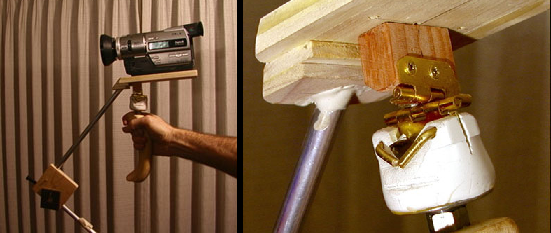We’ve all prematurely stopped watching some Youtube video because of shaky camera work that makes the video unwatchable. There is a solution available for this problem, it’s a device called a camera stabilizer and it is designed to compensate for jerky camera movement. There are several types available for purchase but they can get fairly expensive. Even the cheaper ones at a few hundred dollars are not economical for hobbyists. [John] set out to make his own camera stabilizer using some unorthodox parts.
[John’s] chose a gimble style design that effectively lowers the camera’s center of gravity down close to the camera persons hand. The handle of the device must also be mounted in a manor to prevent angular and rotation movement of the supporting hand from transferring to the camera.
The handle is from a cement trowel, on top of which is a ball bearing mounted to a threaded rod. A PVC fitting was heated to soften it and the bushing pressed in. This bearing is responsible for allowing the rotational freedom between the handle and the camera. To decouple any angular movements, two hinges were attached to the PVC fitting. The hinges are perpendicular to each other, one allows forward-back tilting while the other allows left-right tilting. The upper hinge is attached to a piece of poplar wood that also serves as a base for the camera.
At this point, if you were to try to hold this contraption with the camera installed, it would immediately tip over due to gravity. To prevent this, the center of gravity of the moving parts (including the camera) must be lowered. [John] did this by using some aluminum tubing to support wood weights that reside lower than the pivot points created by the hinges.
If you like the DIYer-style stabilizers, check this other wooded one out. Want something more polished looking? How about this pistol grip stabilizer?
















What’s a “gimble”?
And don’t you mean “manner”?
Looking on how this mechanism works, I think he meant “Gimbal”.
Really? Do you think so?
Personally, I always prefer to mount my cameras in a manor.
For me, nothing beats a good townhouse. Although I admit it makes the whole arrangement hard to lift.
Somebody got a Home Depot gift card for his birthday! Anyway this does look like a fairly cheap and durable stabilizer for the home Eisenstein while filming the Astrovan Potemkin.
NBC, CBS, etal don’t need this for all their crap. Just a caffine camera person.
I built several “cheap steady cam” rigs myself and can tell from experience that these kinds of hinges don’t work well. They are way too stiff and can even introduce their own “hickups”, since you don’t really have independent 2-axis-motion there.
The best solution I came up with for really smooth movement is using a steel nail as the rotation hinge. You don’t have up-and-down compensation that way, but you get quite close to perfect two-axis smoothing.
Also taking care of the counter-weights is crucial for the rig to work right. I cannot imagine getting a reliable setup with FIXED weights.
This is from a page put up 14 years ago (3/13/00) – there have been some wonderful (and less flimsy) rigs made from hardware store parts since.
F’rinstance (2013) – $15 gets you this: http://lifehacker.com/5977911/this-15-diy-dslr-stabilizer-rig-puts-an-end-to-shaky-cam-forever
The problem is that there aren’t many of the big/heavy camcorders out there any more, so if you’re using a rig for video, it’ll either be a very small & light phone/DV camcorder, a DSLR, or something exotic. These will help the latter two but light cameras and phones suffer from high frequency shake rather than the things that a steadicam rig will fix very well.
Increase phone Inertia with lead or other weight then counter balance as normal.
this sucks. there’s much better and easier diy stabilizers then this shit.
>A PVC fitting was heated to soften it
RIP lungs.
What a sad comment.
When I take video with my (now ancient) Canon G9, the only thing I do is mount it to a folded and collapsed bogen/manfrotto tripod. The tripod adds weight which counteracts inertial movement. It’s rather surprising how much a difference a couple of pounds can make.
Though professional units use a gimbal, I don’t think they’re necessary. Just hold the tripod near the top so that gravity takes care of the rotational tendencies.